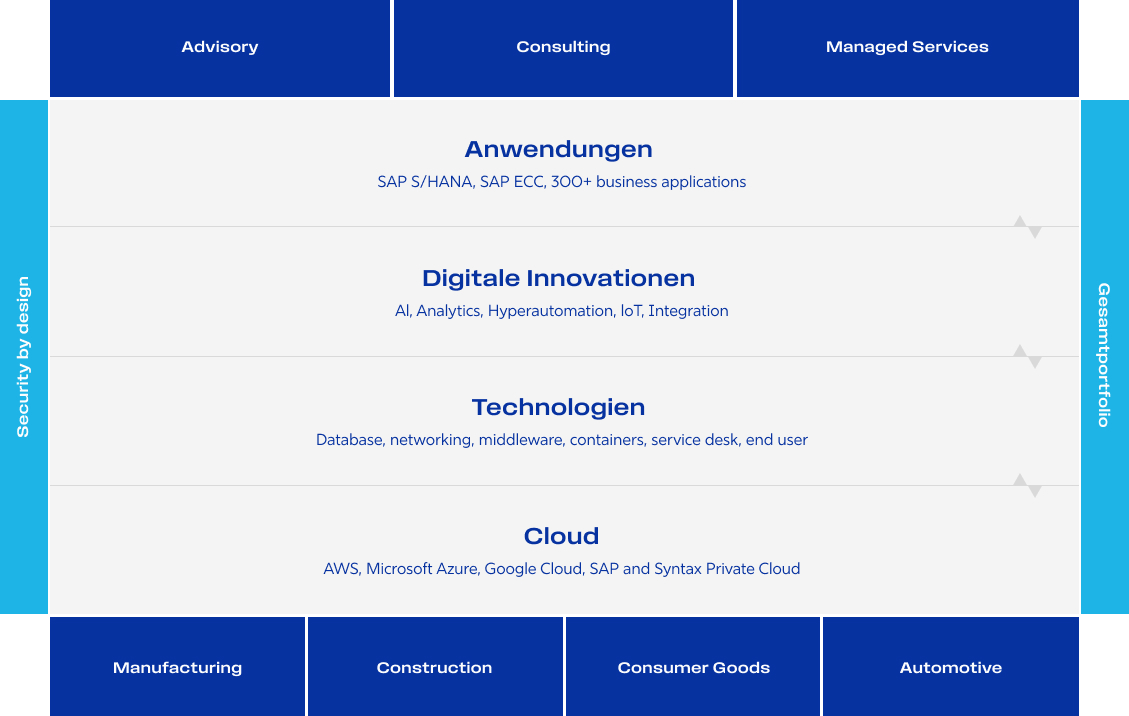Syntax DnA3.
Für schnellere & intelligentere Businessprozesse.

Syntax DnA³.
Für schnellere & intelligentere Businessprozesse.

Syntax bündelt in DnA³ KI, Automatisierung und Analytics
Syntax: Gemeinsam auf Augenhöhe
Mit dem richtigen Partner kann sich Ihr Unternehmen nahtlos weiterentwickeln. Bei Syntax verschmelzen Menschen, Prozesse und Technologie, um die Lücke zwischen dem, was Sie sind, und dem, was Sie erreichen wollen, zu schließen.
MenschenProzessTechnologie
Technische Kompetenz + Branchenkenntnis
Eine erfolgreiche Modernisierung erfordert einen ausgewogenen Ansatz, um das richtige technische Fachwissen mit fundierten Branchenkenntnissen zu sichern.
Wir bieten praktische Unterstützung und Beratung und integrieren nahtlos jede Facette Ihres Unternehmens, um Herausforderungen in Wachstumschancen zu verwandeln und Ihre Vision voranzutreiben, indem wir Ihnen als vertrauenswürdiger Berater zur Seite stehen.
Manufacturing
Integrieren Sie Automatisierung, Robotik und das industrielle Internet der Dinge (IIoT), um die Produktion zu optimieren, Ausfallzeiten zu minimieren und die Qualität zu verbessern.
Retail
Unterstützen Sie Ihre Abläufe mit flexiblen, technologiebasierten Lösungen, um Kosten zu senken, die Effizienz zu steigern und unübertroffene Kundenerlebnisse zu schaffen.
Automotive
Führen Sie sichere, integrierte und cloudbasierte ERP-Lösungen ein, die den gesamten Projektlebenszyklus unterstützen und Innovation ermöglichen.
Construction
Nutzen Sie Building Information Modeling (BIM), Projektmanagement-Software und das Internet der Dinge (IoT), um Projekteffizienz, Sicherheit und Lieferzeiten zu verbessern.

Die Entscheidungen, die Sie treffen müssen, um den Erfolg Ihres Projekts zu gewährleisten, können schwierig sein – daher ist ein vertrauenswürdiger Berater unerlässlich, um den größtmöglichen Nutzen aus Ihrer digitalen Investition zu ziehen.
– Christian Primeau, Global CEO

VerfahrenTechnologieMenschen

Individuell.
Kompetent.
Skalierbar.
Wir aktualisieren nicht einfach nur Ihre Unternehmenssoftware – wir betrachten jeden Kunden als langfristigen Partner, der sein Unternehmen durch branchenkundige Best Practices, fortlaufenden Support und verwaltete Dienste verändert.
Unser auf den Mittelstand zugeschnittener Boutique-Ansatz bietet einen personalisierten, hochwertigen Service, der den Anforderungen und Besonderheiten des lokalen Marktes gerecht wird und gleichzeitig die Fähigkeiten eines global integrierten Unternehmens nutzt.
Wie wir zusammenarbeiten können
SAP-Implementations
+ Migrations
Sorgen Sie für einen nahtlosen Übergang Ihrer Geschäftsprozesse, egal ob Sie gerade erst mit SAP beginnen oder die nächste Stufe erreichen wollen.
Syntax Application
Managed Services
Erhalten Sie erstklassigen Support für Ihre SAP-Anwendungen, um eine konsistente Systemleistung, Skalierbarkeit und Anpassung an sich ändernde Geschäftsanforderungen zu gewährleisten.
RISE with SAP
Beschleunigen Sie Ihre digitale Transformation mit RISE with SAP – einem umfassenden Angebot, das SAP-Lösungen und -Services nahtlos integriert und Ihre Geschäftsprozesse optimiert.
Syntax GenAI
Gestalten Sie Ihre GenAI-Reise nach Ihren individuellen Vorgaben und machen Sie sie zukunftssicher. Profitieren Sie von der Flexibilität bei der Auswahl von Hyperscalern und LLM-Modellen sowie vom zuverlässigen Support der GenAI-Experten von Syntax.
Industrial Internet of Things (IIoT)
Syntax unterstützt Sie dabei, IIoT zu nutzen, um Industrieanlagen zu vernetzen, die Effizienz zu steigern, vorausschauende Wartung zu ermöglichen, Ausfallzeiten zu reduzieren und die Leistung zu optimieren.
Hyperautomation
Nutzen Sie die umfassende Expertise von Syntax in der Fertigung, um maßgeschneiderte Automatisierungsstrategien und -lösungen für Ihre spezifischen Anwendungsfälle zu entwickeln.
TechnologieMenschenProzess
Kompletter Technologie-Stack.
Volles Potenzial.
Was sind die Voraussetzungen für einen Anbieter von Komplettlösungen? Die Bewältigung echter geschäftlicher Herausforderungen auf allen Ebenen, von unternehmenskritischen Abläufen bis hin zu innovativen Geschäftsmodellen.
Erleben Sie die Leistungsfähigkeit eines umfassenden Tech-Stacks mit Syntax und kommen Sie schneller zum Erfolg.
Syntax Produkte & Dienstleistungen
















